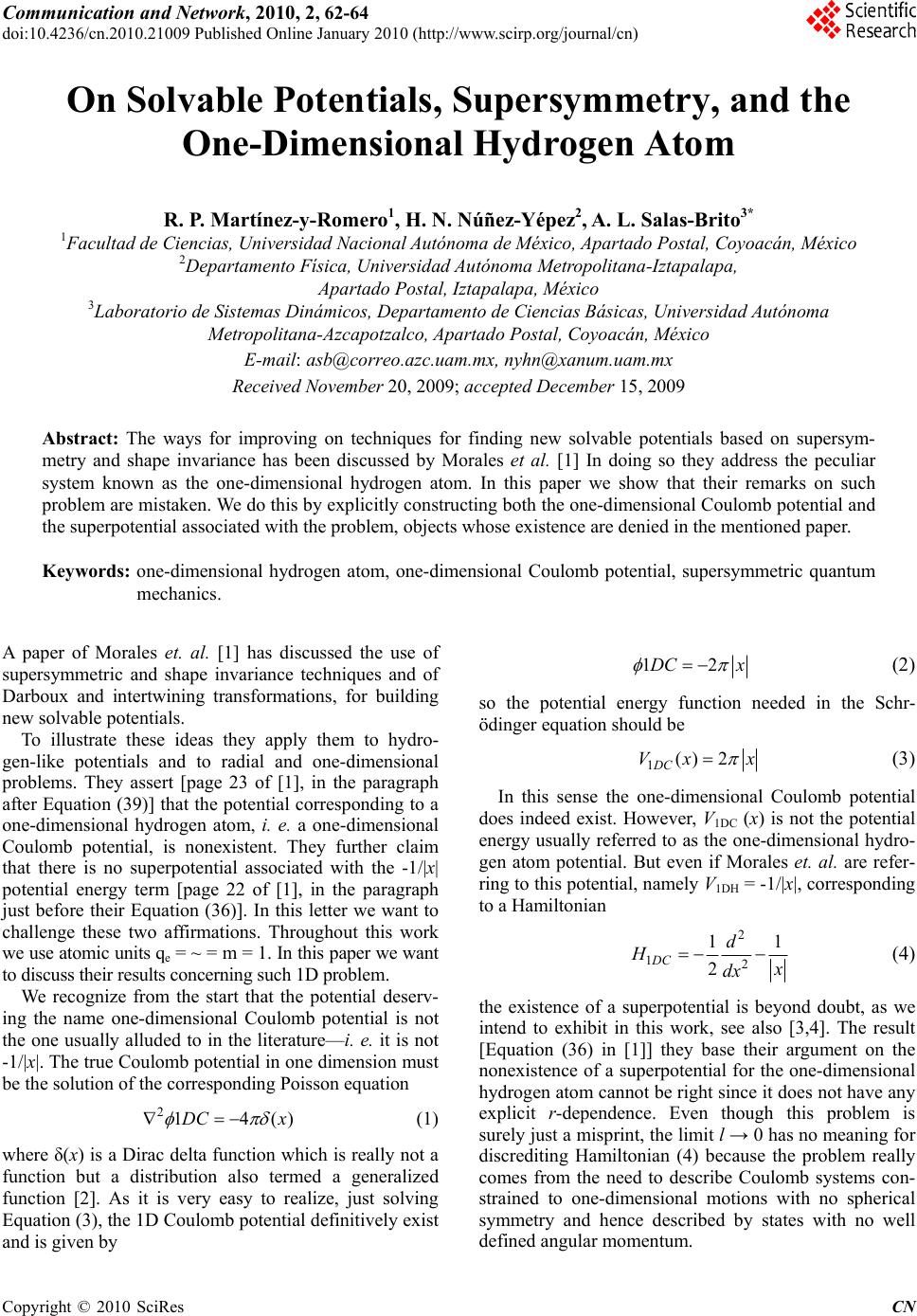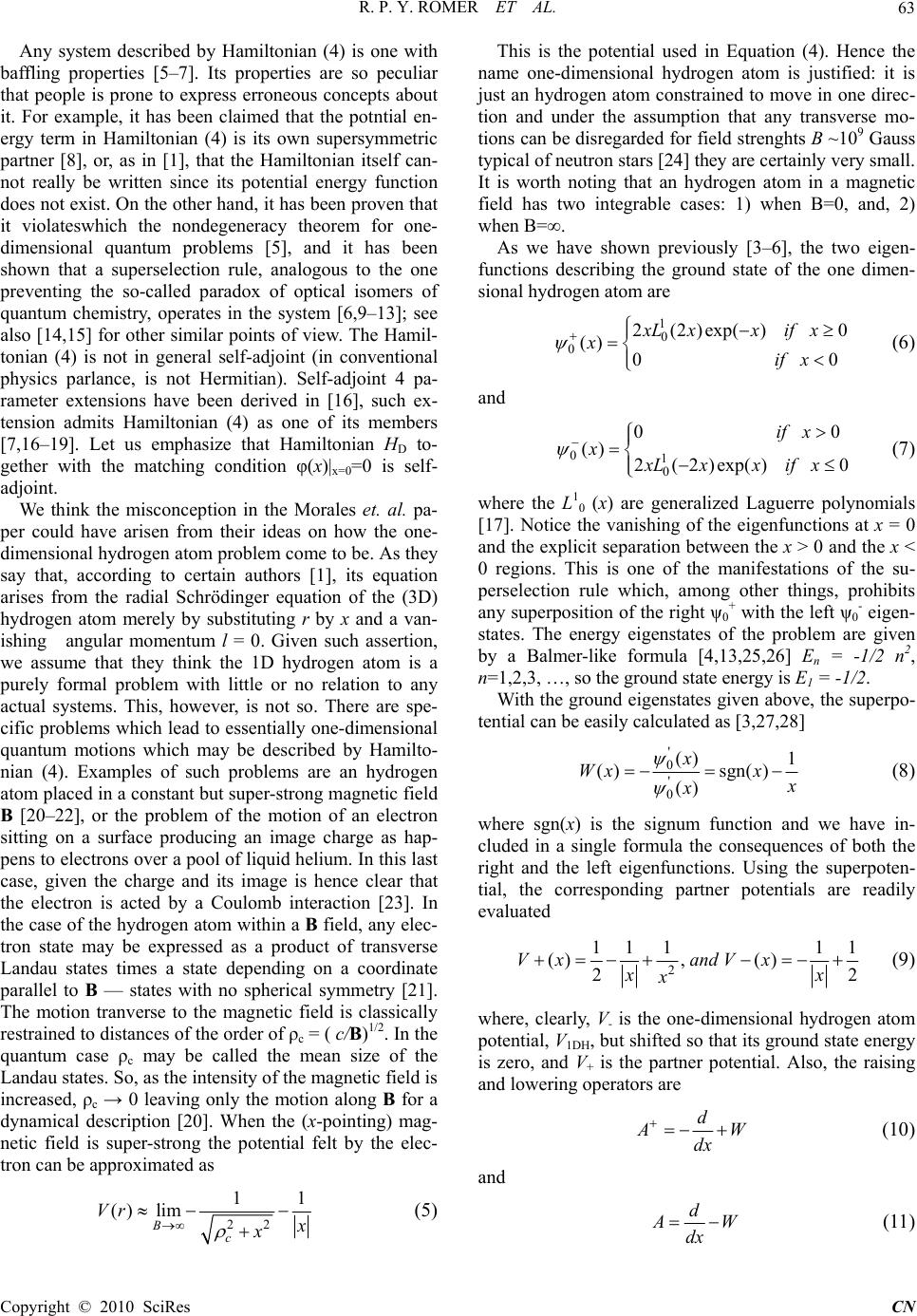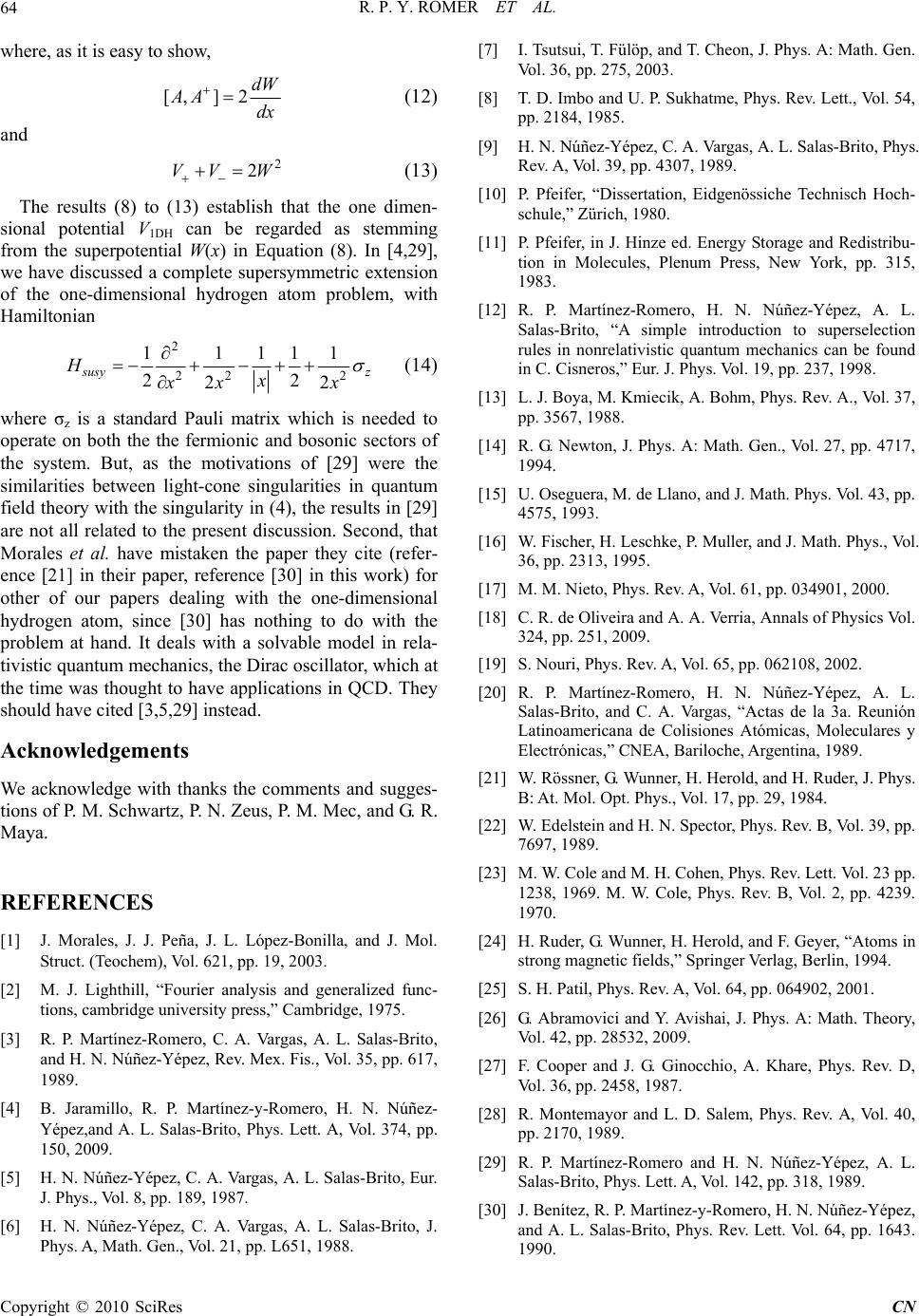Paper Menu >>
Journal Menu >>
 Communication and Network, 2010, 2, 62-64 doi:10.4236/cn.2010.21009 Published Online January 2010 (http://www.scirp.org/journal/cn) Copyright © 2010 SciRes CN On Solvable Potentials, Supersymmetry, and the One-Dimensional Hydrogen Atom R. P. Martínez-y-Romero1, H. N. Núñez-Yépez2, A. L. Salas-Brito3* 1Facultad de Ciencias, Universidad Nacional Autónoma de México, Apartado Postal, Coyoacán, México 2Departamento Física, Universidad Autónoma Metropolitana-Iztapalap a, Apartado Postal, Iztapalapa, México 3Laboratorio de Sistemas Dinámicos, Departamento de Ciencias Básicas, Universidad Autónoma Metr opolitana-Azcapotzalco, Apartado Postal, Coyoacán, México E-mail: asb@correo.azc.uam. mx, nyhn@xanum .uam.mx Received November 20, 2009; accepted December 15, 2009 Abstract: The ways for improving on techniques for finding new solvable potentials based on supersym- metry and shape invariance has been discussed by Morales et al. [1] In doing so they address the peculiar system known as the one-dimensional hydrogen atom. In this paper we show that their remarks on such problem are mistaken. We do this by explicitly constructing both the one-dimensional Coulomb potential and the superpotential associated with the problem, objects whose existence are denied in the mentioned paper. Keywords: one-dimensional hydrogen atom, one-dimensional Coulomb potential, supersymmetric quantum mechanics. A paper of Morales et. al. [1] has discussed the use of supersymmetric and shape invariance techniques and of Darboux and intertwining transformations, for building new solvable potentials. To illustrate these ideas they apply them to hydro- gen-like potentials and to radial and one-dimensional problems. They assert [page 23 of [1], in the paragraph after Equation (39)] that the potential corresponding to a one-dimensional hydrogen atom, i. e. a one-dimensional Coulomb potential, is nonexistent. They further claim that there is no superpotential associated with the -1/|x| potential energy term [page 22 of [1], in the paragraph just before their Equation (36)]. In this letter we want to challenge these two affirmations. Throughout this work we use atomic units qe = ~ = m = 1. In this paper we want to discuss their results concerning such 1D problem. We recognize from the start that the potential deserv- ing the name one-dimensional Coulomb potential is not the one usually alluded to in the literature—i. e. it is not -1/|x|. The true Coulomb potential in one dimension must be the solution of the corresponding Poisson equation 214()DC x (1) where δ(x) is a Dirac delta function which is really not a function but a distribution also termed a generalized function [2]. As it is very easy to realize, just solving Equation (3), the 1D Coulomb potential definitively exist and is given by 12DC x (2) so the potential energy function needed in the Schr- ödinger equation should be 1() 2 DC Vx x (3) In this sense the one-dimensional Coulomb potential does indeed exist. However, V1DC (x) is not the potential energy usually referred to as the one-dimensional hydro- gen atom potential. But even if Morales et. al. are refer- ring to this potential, namely V1DH = -1/|x|, corresponding to a Hamiltonian 2 12 11 2 DC d H x dx (4) the existence of a superpotential is beyond doubt, as we intend to exhibit in this work, see also [3,4]. The result [Equation (36) in [1]] they base their argument on the nonexistence of a superpotential for the one-dimensional hydrogen atom cannot be right since it does not have any explicit r-dependence. Even though this problem is surely just a misprint, the limit l → 0 has no meaning for discrediting Hamiltonian (4) because the problem really comes from the need to describe Coulomb systems con- strained to one-dimensional motions with no spherical symmetry and hence described by states with no well defined angular momentum.  R. P. Y. ROMER ET AL. Copyright © 2010 SciRes CN 63 Any system described by Hamiltonian (4) is one with baffling properties [5–7]. Its properties are so peculiar that people is prone to express erroneous concepts about it. For example, it has been claimed that the potntial en- ergy term in Hamiltonian (4) is its own supersymmetric partner [8], or, as in [1], that the Hamiltonian itself can- not really be written since its potential energy function does not exist. On the other hand, it has been proven that it violateswhich the nondegeneracy theorem for one- dimensional quantum problems [5], and it has been shown that a superselection rule, analogous to the one preventing the so-called paradox of optical isomers of quantum chemistry, operates in the system [6,9–13]; see also [14,15] for other similar points of view. The Hamil- tonian (4) is not in general self-adjoint (in conventional physics parlance, is not Hermitian). Self-adjoint 4 pa- rameter extensions have been derived in [16], such ex- tension admits Hamiltonian (4) as one of its members [7,16–19]. Let us emphasize that Hamiltonian HD to- gether with the matching condition φ(x)|x=0=0 is self- adjoint. We think the misconception in the Morales et. al. pa- per could have arisen from their ideas on how the one- dimensional hydrogen atom problem come to be. As they say that, according to certain authors [1], its equation arises from the radial Schrödinger equation of the (3D) hydrogen atom merely by substituting r by x and a van- ishing angular momentum l = 0. Given such assertion, we assume that they think the 1D hydrogen atom is a purely formal problem with little or no relation to any actual systems. This, however, is not so. There are spe- cific problems which lead to essentially one-dimensional quantum motions which may be described by Hamilto- nian (4). Examples of such problems are an hydrogen atom placed in a constant but super-strong magnetic field B [20–22], or the problem of the motion of an electron sitting on a surface producing an image charge as hap- pens to electrons over a pool of liquid helium. In this last case, given the charge and its image is hence clear that the electron is acted by a Coulomb interaction [23]. In the case of the hydrogen atom within a B field, any elec- tron state may be expressed as a product of transverse Landau states times a state depending on a coordinate parallel to B — states with no spherical symmetry [21]. The motion tranverse to the magnetic field is classically restrained to distances of the order of ρc = ( c/B)1/2. In the quantum case ρc may be called the mean size of the Landau states. So, as the intensity of the magnetic field is increased, ρc → 0 leaving only the motion along B for a dynamical description [20]. When the (x-pointing) mag- netic field is super-strong the potential felt by the elec- tron can be approximated as 22 11 () lim Bc Vr x x (5) This is the potential used in Equation (4). Hence the name one-dimensional hydrogen atom is justified: it is just an hydrogen atom constrained to move in one direc- tion and under the assumption that any transverse mo- tions can be disregarded for field strenghts B ~109 Gauss typical of neutron stars [24] they are certainly very small. It is worth noting that an hydrogen atom in a magnetic field has two integrable cases: 1) when B=0, and, 2) when B=∞. As we have shown previously [3–6], the two eigen- functions describing the ground state of the one dimen- sional hydrogen atom are 1 0 0 2(2)exp() 0 () 00 xLxxif x xif x (6) and 01 0 00 () 2(2)exp() 0 if x xxLxxif x (7) where the L1 0 (x) are generalized Laguerre polynomials [17]. Notice the vanishing of the eigenfunctions at x = 0 and the explicit separation between the x > 0 and the x < 0 regions. This is one of the manifestations of the su- perselection rule which, among other things, prohibits any superposition of the right ψ0 + with the left ψ0 - eigen- states. The energy eigenstates of the problem are given by a Balmer-like formula [4,13,25,26] En = -1/2 n2, n=1,2,3, …, so the ground state energy is E1 = -1/2. With the ground eigenstates given above, the superpo- tential can be easily calculated as [3,27,28] ' 0 ' 0 () 1 () sgn() () x Wx x x x (8) where sgn(x) is the signum function and we have in- cluded in a single formula the consequences of both the right and the left eigenfunctions. Using the superpoten- tial, the corresponding partner potentials are readily evaluated 2 11 111 (), () 22 Vxand Vx xx x (9) where, clearly, V- is the one-dimensional hydrogen atom potential, V1DH, but shifted so that its ground state energy is zero, and V+ is the partner potential. Also, the raising and lowering operators are d A W dx (10) and d A W dx (11)  R. P. Y. ROMER ET AL. Copyright © 2010 SciRes CN 64 where, as it is easy to show, [,] 2 dW AA dx (12) and 2 2VV W (13) The results (8) to (13) establish that the one dimen- sional potential V1DH can be regarded as stemming from the superpotential W(x) in Equation (8). In [4,29], we have discussed a complete supersymmetric extension of the one-dimensional hydrogen atom problem, with Hamiltonian 2 22 2 11111 22 22 s usy z Hx xx x (14) where σz is a standard Pauli matrix which is needed to operate on both the the fermionic and bosonic sectors of the system. But, as the motivations of [29] were the similarities between light-cone singularities in quantum field theory with the singularity in (4), the results in [29] are not all related to the present discussion. Second, that Morales et al. have mistaken the paper they cite (refer- ence [21] in their paper, reference [30] in this work) for other of our papers dealing with the one-dimensional hydrogen atom, since [30] has nothing to do with the problem at hand. It deals with a solvable model in rela- tivistic quantum mechanics, the Dirac oscillator, which at the time was thought to have applications in QCD. They should have cited [3,5,29] instead. Acknowledgements We acknowledge with thanks the comments and sugges- tions of P. M. Schwartz, P. N. Zeus, P. M. Mec, and G. R. Maya. REFERENCES [1] J. Morales, J. J. Peña, J. L. López-Bonilla, and J. Mol. Struct. (Teochem), Vol. 621, pp. 19, 2003. [2] M. J. Lighthill, “Fourier analysis and generalized func- tions, cambridge university press,” Cambridge, 1975. [3] R. P. Martínez-Romero, C. A. Vargas, A. L. Salas-Brito, and H. N. Núñez-Yépez, Rev. Mex. Fis., Vol. 35, pp. 617, 1989. [4] B. Jaramillo, R. P. Martínez-y-Romero, H. N. Núñez- Yépez,and A. L. Salas-Brito, Phys. Lett. A, Vol. 374, pp. 150, 2009. [5] H. N. Núñez-Yépez, C. A. Vargas, A. L. Salas-Brito, Eur. J. Phys., Vol. 8, pp. 189, 1987. [6] H. N. Núñez-Yépez, C. A. Vargas, A. L. Salas-Brito, J. Phys. A, Math. Gen., Vol. 21, pp. L651, 1988. [7] I. Tsutsui, T. Fülöp, and T. Cheon, J. Phys. A: Math. Gen. Vol. 36, pp. 275, 2003. [8] T. D. Imbo and U. P. Sukhatme, Phys. Rev. Lett., Vol. 54, pp. 2184, 1985. [9] H. N. Núñez-Yépez, C. A. Vargas, A. L. Salas-Brito, Phys. Rev. A, Vol. 39, pp. 4307, 1989. [10] P. Pfeifer, “Dissertation, Eidgenössiche Technisch Hoch- schule,” Zürich, 1980. [11] P. Pfeifer, in J. Hinze ed. Energy Storage and Redistribu- tion in Molecules, Plenum Press, New York, pp. 315, 1983. [12] R. P. Martínez-Romero, H. N. Núñez-Yépez, A. L. Salas-Brito, “A simple introduction to superselection rules in nonrelativistic quantum mechanics can be found in C. Cisneros,” Eur. J. Phys. Vol. 19, pp. 237, 1998. [13] L. J. Boya, M. Kmiecik, A. Bohm, Phys. Rev. A., Vol. 37, pp. 3567, 1988. [14] R. G. Newton, J. Phys. A: Math. Gen., Vol. 27, pp. 4717, 1994. [15] U. Oseguera, M. de Llano, and J. Math. Phys. Vol. 43, pp. 4575, 1993. [16] W. Fischer, H. Leschke, P. Muller, and J. Math. Phys., Vol. 36, pp. 2313, 1995. [17] M. M. Nieto, Phys. Rev. A, Vol. 61, pp. 034901, 2000. [18] C. R. de Oliveira and A. A. Verria, Annals of Physics Vol. 324, pp. 251, 2009. [19] S. Nouri, Phys. Rev. A, Vol. 65, pp. 062108, 2002. [20] R. P. Martínez-Romero, H. N. Núñez-Yépez, A. L. Salas-Brito, and C. A. Vargas, “Actas de la 3a. Reunión Latinoamericana de Colisiones Atómicas, Moleculares y Electrónicas,” CNEA, Bariloche, Argentina, 1989. [21] W. Rössner, G. Wunner, H. Herold, and H. Ruder, J. Phys. B: At. Mol. Opt. Phys., Vol. 17, pp. 29, 1984. [22] W. Edelstein and H. N. Spector, Phys. Rev. B, Vol. 39, pp. 7697, 1989. [23] M. W. Cole and M. H. Cohen, Phys. Rev. Lett. Vol. 23 pp. 1238, 1969. M. W. Cole, Phys. Rev. B, Vol. 2, pp. 4239. 1970. [24] H. Ruder, G. Wunner, H. Herold, and F. Geyer, “Atoms in strong magnetic fields,” Springer Verlag, Berlin, 1994. [25] S. H. Patil, Phys. Rev. A, Vol. 64, pp. 064902, 2001. [26] G. Abramovici and Y. Avishai, J. Phys. A: Math. Theory, Vol. 42, pp. 28532, 2009. [27] F. Cooper and J. G. Ginocchio, A. Khare, Phys. Rev. D, Vol. 36, pp. 2458, 1987. [28] R. Montemayor and L. D. Salem, Phys. Rev. A, Vol. 40, pp. 2170, 1989. [29] R. P. Martínez-Romero and H. N. Núñez-Yépez, A. L. Salas-Brito, Phys. Lett. A, Vol. 142, pp. 318, 1989. [30] J. Benítez, R. P. Martínez-y-Romero, H. N. Núñez-Yépez, and A. L. Salas-Brito, Phys. Rev. Lett. Vol. 64, pp. 1643. 1990. |

